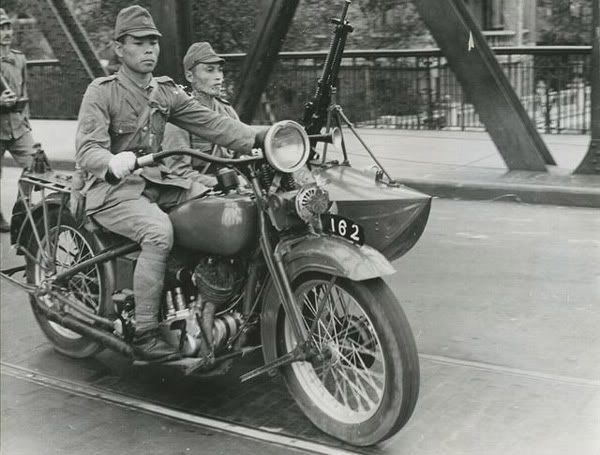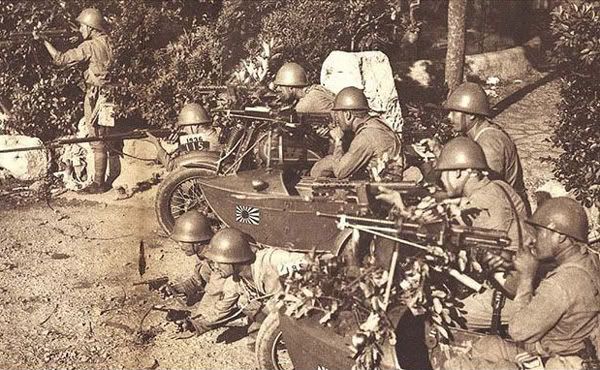
 By
the early 1930s, the Imperial Japanese Army (IJA) was determined to
stop importing machines and parts, especially in strategic or
defense-related industries. The IJA aimed to sponsor or help found
companies that could do the same job domestically, so the army
approached a drug-manufacturing company in Tokyo called Sankyo Seiyaku.
(They're still in business today, making cold remedies and so on.)
Sankyo was "asked" to manage a new motorcycle business. When the
military asked for help back then, few companies were in a position to
refuse.
By
the early 1930s, the Imperial Japanese Army (IJA) was determined to
stop importing machines and parts, especially in strategic or
defense-related industries. The IJA aimed to sponsor or help found
companies that could do the same job domestically, so the army
approached a drug-manufacturing company in Tokyo called Sankyo Seiyaku.
(They're still in business today, making cold remedies and so on.)
Sankyo was "asked" to manage a new motorcycle business. When the
military asked for help back then, few companies were in a position to
refuse.The IJA was already happy with Harley's 1200 cc flathead bike, which it had been using for many years, so in 1932 Sankyo sent representatives to Milwaukee and arranged to purchase the entire 1200 cc factory. Times were lean in the U.S. then, and Harley Davidson agreed to the deal.
In 1933, the factory was broken up, sent to the coast, shipped to Japan, and rebuilt at Kita-Shinagawa, Tokyo, where Sankyo still manufactures pharmaceuticals today. The money for the land, the facilities, and the wages for 100 employees was provided by the IJA, and the deal was brokered through a proxy company that the army set up in Tokyo. Several of Harley's technicians went along to help erect the plant and set up the machinery. Harley provided all the necessary tools, dies, presses, and heat-treating secrets. The licensing fee paid by Sankyo was spread out over the next four years.
Domestic production was soon underway, and the machines were sold initially as Japanese-made Harley Davidsons, with the name "Rikuo," or "Road King," given to them to make them seem more like a domestic product. The army-use versions were known as the Type-97 motorcycle. The Rikuo was so successful that in 1936 Sankyo decided to change the subsidiary company's name to Rikuo Nainenki KK (Rikuo Internal Engine Co., Inc.). In that year, Harley Davidson wanted to add their new EL "knucklehead" design to the licensing deal, but Sankyo wasn't pleased with its performance, so when it refused, the relationship basically deteriorated.
Rikuo would build the 1200cc flathead design right through the war, and five other Japanese companies would also build various versions of the Type-97 machine as well. They later added a transaxle and rear differential to drive the sidecar wheel, which was essential in the muddy terrain of Manchuria and China. I also discuss some of the other firms in detail, such as Meguro and Orient Industries (later Mazda), both of which also built the Type-97 during the war era.
Harley Davidson's decision to sell the factory to Japan in 1932, the year after Japan's invasion of Manchuria, was not seen as especially controversial then. Sankyo was a civilian firm, and the fact that the money came from the IJA was not disclosed by Sankyo. Also, the deal was brokered by a proxy company, so it wasn't direct support of Japan's military or Japan's foreign policy by Harley Davidson. The 1200cc motorcycle was sold to wealthy civilians as well as to the army, both in Japan and in Manchuria, and was used throughout the Japanese empire until 1945.
Today, Sankyo refuses to discuss the subject, but I've read their published Japanese histories, which can be found in major research university libraries. They're not proud of the episode, especially their sale of the machine in occupied areas, so they keep quiet about it. As far as research is concerned, I don't think these episodes have to be celebrated in order to be studied.
Via: Dr. A's post from Rider info.com
No comments:
Post a Comment